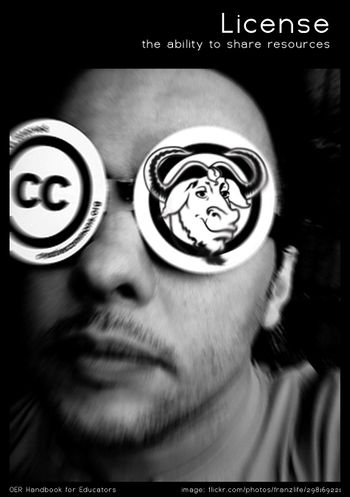Remix and compatibility
| Course dashboard for #OCL4Ed | ||
|---|---|---|
| Creative Commons unplugged | Video signpost - Cathy Casserly | Introduction | The CC basics | CC overview | The CC licenses | Anatomy of a CC license | Remix and compatibility | Remix game | Summary | E-Activity - Remix and reflection | |
The ability to remix, adapt or re-purpose education material is a significant advantage of open educational resources (OER) when compared to closed learning materials. Remix refers to the ability to combine different resources together to create new derivative works. Creators of OER often combine learning materials from a variety of sources together, or add their own creativity to existing works to create a new educational resource which they in turn re-license openly. However, the legal terms of one license may not be compatible with the legal terms of another license.
We need to consider the compatibility of different licenses when remixing materials, that is creating a derivative work. Note that license compatibility applies when creating derivative works. Reusing materials without adaptation (such as copying or redistributing verbatim) is easy with Creative Commons as long as you comply with the original license conditions.
Contents
Defining derivative works
As license compatibility relates to derivative works or adaptations, we must first explain what Creative Commons means by a derivative work.A derivative work is a work that is based on another work but is not an exact, verbatim copy. What this means exactly and comprehensively is the subject of many law journal articles and much debate and pontification. In general, a translation from one language to another or a film version of a book are examples of derivative works. Combining a number of CC[1]-licensed learning materials with your own original creations is also a derivative work. Under the CC core licenses, synching music in timed-relation with a moving image is considered to be a derivative work. (For more information, see how a CC license defines "Adaptation" and "Collection".)
Under general "all rights reserved" copyright law, format shifting from one medium to another, e.g., a digital image in jpg format converted to the gif format, is considered a copy, and not permitted. In contrast, the CC licenses allow the user to exercise the rights permitted under the license in any format or media, even in licenses including No-Derivatives. This means that, under the Creative Commons Attribution Non-Commercial No-Derivatives license, for example, you may copy the work from a digital file to a print file consistent with the terms of that license. (For more information see section 3. License Grant.
The compatibility challenge
It seems only natural to assume that an OER with a CC license could be mixed with another OER using a CC license or alternative open content license like the GNU Free Documentation License (GFDL). However, this is not the case. For example:
- A CC license with a No-Derivatives restriction means that it cannot be remixed with other CC-licensed content because of the no-derivatives requirement;
- Different open content licenses may restrict remixing with other license types because of the specific licensing requirements for derivative works. For example, the GFDL requires that derivative works are released under precisely the same license, meaning the GFDL. Therefore it is not legally permissible to mix-in GFDL content and release the derivative work under a CC BY-SA license, even though these licenses are similar in terms of the intent of the licenses.
However, it is possible to release original works under a dual license, that is both a CC license and GFDL. (Note that this applies to original works, which are not derivative works, but dual licensing can facilitate greater flexibility for downstream remixing.) It is also possible to release a collection under their respective licenses, where the sub-sections can be clearly identified as discrete parts. In other words, part of the material is licensed with a CC license(s) and part GFDL, provided that the original terms of the respective licenses are adhered to.
For the purposes of this tutorial, we will restrict our discussion of license compatibility among the CC licenses and not address the complexities of compatibility among different licenses. If in doubt, when mixing content from licenses other than Creative Commons, get legal advice or contact the copyright holder for release of the work under a corresponding CC license.
Compatibility among different CC licenses
Generally speaking, when creating a derivative work, the more open the CC license of the source materials, the more options there are available for the licensing of resulting works. It is legally possible to add more restrictions than the original license in some cases, for example, releasing a derivative work under all rights reserved which incorporates source materials licensed under a Creative Commons Attribution license. However, as educators we should do our best to respect the original intent of the creator for releasing his or her works freely. In education, doing the right thing (sharing knowledge freely) is more important than doing things right (legal options for adding restrictions).At first, license compatibility appears confusing and complex, however the compatibility chart below will assist. When reading the chart, start with the license of the original work on the left. The green boxes indicate license compatibility. That is, you may use the license indicated in the top row for your derivative work or adaptation. The blank rows for the BY-NC-ND and BY-ND licenses indicate that derivative works or adaptations are not permitted by the license of the original work, therefore you are not allowed to re-license them. However, you can always contact the creator of the original work directly to obtain permissions beyond the CC license.
| Compatibility chart |
License terms that may be used for a derivative work or adaptation | ||||||||||||||||
| BY |
BY-NC | BY-NC-ND | BY-NC-SA | BY-ND | BY-SA | PD | |||||||||||
| Status of the original work |
PD |
|
|
|
|
|
|
| |||||||||
| BY | |
|
|
|
|
|
| ||||||||||
| BY-NC | |
|
|
|
|
|
| ||||||||||
| BY-NC-ND | |
|
|
|
|
|
| ||||||||||
| BY-NC-SA | |
|
|
|
|
|
| ||||||||||
| BY-ND | |
|
|
|
|
|
| ||||||||||
| BY-SA | |
|
|
|
|
|
| ||||||||||
- Note: The public domain (PD) is not a license. Works enter into the public domain when copyright expires or where the creator waives intellectual property rights. Therefore the public domain cannot legally be a license because there are no intellectual property rights which need a licensee for usage. However, the table above is about compatibility and it is legally possible to incorporate works dedicated to the public domain into works licensed under all the CC licenses.
The above compatibility chart shows that resources under a CC BY license can be combined with resources licensed under any other CC license, and may be re-licensed under any other CC license. CC BY is the license most compatible with other CC licenses, and as a result, we recommend CC BY for use in OER. Unfortunately, you cannot apply a CC BY license to your OER if you have used or remixed materials made available under more restrictive licenses. Below we explain which licenses you may use, depending on the license terms of the underlying resources:
- Resources licensed under CC BY-NC can only be remixed, adapted, and re-licensed into resources containing an NC (Non-Commercial) term, which includes CC BY-NC, CC BY-NC-SA, and CC BY-NC-ND.
- Resources licensed under CC BY-SA and CC BY-NC-SA can only be incorporated into derivative works which are re-licensed under the same license (e.g. * BY-SA with BY-SA, and BY-NC-SA with BY-NC-SA) due to their SA (Share Alike) term. (However, it is for example, possible to incorporate CC BY with CC BY-SA resources if the resultant work is released under the CC BY-SA license).
- Resources licensed under CC BY-ND and CC BY-NC-ND cannot be incorporated into a derivative work, and therefore they may not be re-licensed, due to the ND (No Derivatives) term in the license.
Summary
As you become more familiar with the licensing terms of the different CC licenses and start remixing educational materials, license compatibility will become second nature. Remember these guidelines:
- Creative works dedicated to the public domain can be remixed with all the CC license types. (Remember that the public domain is not a license.)
- The Creative Commons Attribution license may be re-licensed using any of the six license types.
- Generally speaking, you may not re-license derivative works under more open licenses without prior consent from the copyright holder.
- You may never remix source materials containing a No-Derivatives restriction (however, format shifts are permissible).
- If you include any source materials using the Share-Alike provision, the derivative work must be released under the identical license. (You may include CC BY materials in a CC BY-SA or CC BY-NC-SA licensed derivative work.)
Acknowledgements
Some content on this page was sourced from:
Notes

